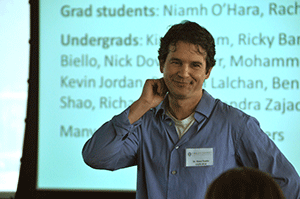Climate change is considered a pressing problem among the scientific community. Unfortunately, the general public does not share its concern.
Steven Franks, Ph.D., opened this year’s Summer Undergraduate Research symposium with some bleak statistics. According to Franks, only 32 percent of Americans believe that evolution—the way organisms adapt to change—is a natural process, and only 54 percent believe humans are responsible for the environmental changes that are forcing adaptive evolution.

And yet, 73 percent of people hold at least one belief in a paranormal phenomenon, which, unlike climate change, has “no scientific basis whatsoever,” Franks said.
“In other words, you may get more support from the public if you were studying telepathy and unicorns than if you were studying climate change and evolution,” said Franks, an associate professor of biological sciences.
Franks and six undergraduate students presented research at the symposium, marking the conclusion of this year’s Calder Summer Undergraduate Research program (CSUR) and the biology department’s Summer Science Internship Program.
Run by Fordham’s Louis Calder Center, the program offers paid research opportunities for undergraduate students in a variety of biological field studies. Students work with Calder staff ecologists at study sites and nearby ecosystems, such as the Hudson River, Long Island Pine Barrens, Mianus River Gorge, and the Catskill Mountains. Over ten weeks, students conduct a research project of their own and present their findings to researchers and members of the station.
Franks, who studies evolutionary ecology of plants and invasive species, gave the symposium’s keynote, “Evolving in a Climate of Change.” Evolution, he explained, is the central theory of biology and is the main way scientists explain changes in the natural world. Organisms tend to fit in with their environments—for instance, plants that require a lot of moisture live in tropical environments, while plants that don’t live in the desert. If their environment changes, evolution makes it possible for organisms to adapt along with it.
Unfortunately, that natural process is experiencing increasing interference.
“Humans are changing the environment at a rapid rate in a number of different ways, one of the most important being climate—changes in temperature, precipitation, etc. Others include changing land use, pollution, and the introduction of invasive species,” Franks said.
Jodie Crose (Oklahoma State University), Pollen Limitation in Penstemon digitalis;To find out how species adapt to rapid environmental changes, and how they fare as a result, Franks and his team studied a plant known as Brassica rapa, which grows abundantly in California. Up until 1997, California enjoyed adequate rainfall and Brassica rapa thrived. But a drought that began in 1997 and lasted until 2004 forced the plant to make changes in order to survive.

The team found that Brassica rapa adapted to its dryer environment by flowering much earlier than it normally does. This adjustment allowed them to reproduce before the drought could kill them off.
On the face of it, an adjustment that ensures the plants’ survival seems beneficial. However, the team realized the adaptation had an unfortunate consequence. The plants that carried the trait of early flowering also carried the trait of having thinner leaves—a trait that made them more susceptible to disease.
“Rapid evolution can occur in response to change, but it doesn’t always happen fast enough,” Franks said. “And even if it does, adaption to climate change can have costs.”
The students who received CSUR grants and presented their research at the symposium were:
- Nadeen Matari (Fordham University), Adaptive and Innate Immunogenetic Variation in an Endandgered Species, the Black Lion Tamarin (Leontopithecus chrysopygus);
- Megan Bishop (Humboldt State University), Variation in Flower Types in Clasping Venus Looking Glass (Triodanis perfoliata);
- Patrick Alford (Fordham University), Cryptic Sucker Species of the Northeast;
- Alyssa Ammazzalorso (Fordham University), To Beat or Not to Beat a Tick; and
- Colette Berg (Fordham University), Field Work and Rosedale Outreach: Summer 2014.
Founded in 1841, Fordham is the Jesuit University of New York, offering exceptional education distinguished by the Jesuit tradition to more than 15,100 students in its four undergraduate colleges and its six graduate and professional schools. It has residential campuses in the Bronx and Manhattan, a campus in West Harrison, N.Y., the Louis Calder Center Biological Field Station in Armonk, N.Y., and the London Centre at Heythrop College, University of London, in the United Kingdom.
